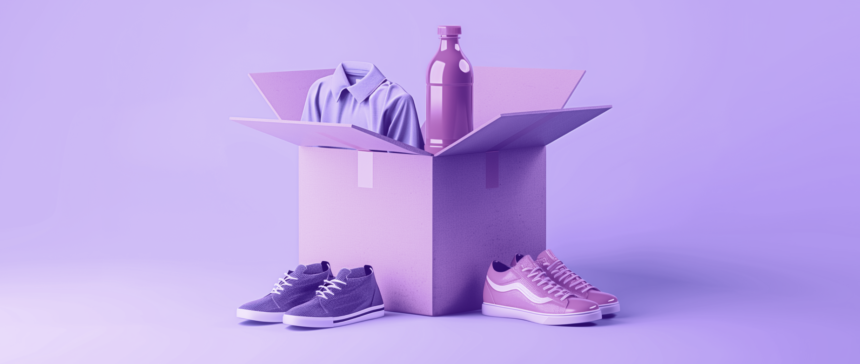From the everyday necessities we rely on to the luxuries that enrich our lives, consumer goods are the lifeblood of the global economy.
Understanding the nuances of consumer goods is essential for businesses seeking to compete in a marketplace rich in choice. Learn the essentials of consumer goods, explore the various subtypes and classifications, and discover their importance in today’s dynamic marketplace.
What are consumer goods?
Consumer goods are those goods that ordinary consumers purchase for their personal use. They are also called final goods since they are the end result of various production processes and are the final destination. supply chainExamples of consumer goods include clothing, electronics, food, appliances, and automobiles.
The sale of most consumer products is regulated by the U.S. Consumer Product Safety Act, which was passed by Congress in 1972 to establish standards for product safety. The act also created the U.S. Consumer Product Safety Commission, which enforces these standards. The commission can also require manufacturers to recall products or ban products that violate safety laws.
📖 Read more: Your guide to safe product sourcing and drop shipping
Consumer Goods and Capital Goods
Economists classify consumer goods as Capital GoodsThese are goods that businesses use to produce and deliver consumer goods, which are intended for direct consumption. In other words, consumer goods are things that are sold. Business to Consumer (B2C)Capital goods are sold Business to Business (B2B).
Types of consumer goods
Consumer goods can be broadly divided into three main categories: durable goods, non-durable goods, and services.
Durable Goods
Durable goods are products that serve a customer with a lifespan of more than three years. They include home appliances such as refrigerators and washing machines, electronic devices such as laptops and smartphones, and vehicles such as bicycles and cars. Durable goods are often the most expensive consumer goods and are considered long-term assets by their owners.
📖 Read more: 20 Trending Products and Items to Sell Online
Non-durable goods
Non-durable goods include consumables, fast-moving consumer goods (FMCG), Consumer Packaged Goods (CPG)Non-durable consumer goods sell well and are consumed relatively quickly.
Examples of nondurable goods include food, beverages, toiletries, laundry detergent, and household cleaners. These items are essential to sustain daily life in a modern economy and are characterized by frequent replenishment cycles. This requires efficient production processes and supply chain management.
service
In addition to tangible goods such as durable and nondurable goods, from an economic perspective, some services are also considered consumer goods. These services are intangible offerings that individuals or businesses provide to satisfy consumer needs. Examples of services that are consumer goods include haircuts, plumbing, car repairs, and even some health care services.
📖 Read more: 8 service business ideas to turn your expertise into profits
Consumer Goods Classification
Consumer goods can be further divided into four main types: convenience goods, shopping items, specialty goods, and non-demand goods. It is important to note that all four of these categories can contain durable goods, non-durable goods, services, or a combination of these.
Convenience goods
Convenience goods are products that consumers purchase frequently and with minimal effort. These products are easily available and are often sold through multiple distribution channels to maximize accessibility. Common examples of convenience goods include household staples such as bread, milk, and toilet paper, as well as more discretionary purchases such as snack foods, alcoholic beverages, and beauty products.
Convenience products are generally low-cost and satisfy basic consumer needs and may not require extensive marketing compared to other types of consumer goods.
Because customers are unlikely to compare different brands of convenience goods before making a purchase decision, marketers tend to prioritize store placement and availability when selling convenience goods.
Shopping Products
Shopping products are products that consumers compare and evaluate based on factors such as price, quality, and brand reputation before purchasing. Purchase decisionThese products often require more research and consideration, reflecting shopper preferences and priorities. As a result, shopping products tend to be purchased less frequently and in the mid-range than convenience products.
Examples of shopping products include clothing, electronics, furniture, appliances, etc., which vary in durability, style, and functionality. Shopping products make up a large portion of consumer spending and require targeted marketing efforts to capture consumer attention and increase sales.
Specialty goods
Specialty products are products with unique characteristics that cater to specific consumer tastes or interests. These items typically command a higher price and target a specialized market segment. Examples of specialty products include luxury watches, fine art, designer clothing, vehicles with special features (pickup trucks, sports cars, etc.), and high-end electronics.
Specialty products require customized marketing strategies and brand positioning to differentiate themselves in a small, competitive market and attract discerning customers.
📖 Read more: Luxury e-commerce tips to attract high-net-worth customers
Unwanted products
Unwanted products are products that consumers don’t actively seek out or consider purchasing until they have a specific need or problem. They are often one-time purchases and typically sell at a higher price point. Examples of unwanted products include insurance, funeral services, and certain healthcare products. Although they address an important need or concern, they may not be a top priority for the consumer.
These products typically require proactive, proactive marketing efforts to build consumer awareness and interest. Unwanted products pose a unique challenge for consumer goods companies looking to stimulate demand and accelerate innovation through targeted marketing campaigns.
Consumer Goods FAQ
Why is it important to understand consumer goods?
Nearly every business in the world’s economy deals directly or indirectly with the consumer goods industry. Different types of consumer goods are suited to different marketing strategies, and understanding the differences can help business owners identify and market their consumer goods appropriately.
What are examples of consumer goods?
Consumer goods include a wide range of products and services, such as:
- Durable goods (household appliances, automobiles)
- Non-durable goods (food, toiletries, detergents)
- Services (haircuts, landscaping, insurance coverage)
- Household goods (drinks, cosmetics, snacks)
- Shopping items (clothing, electronics)
- Specialty products (luxury items)
- Unnecessary products (life insurance, funeral services)
What are the three main categories of consumer goods?
There are three categories of consumer goods: durable goods, nondurable goods, and services. Durable goods have a lifespan of three years or more and include things like household appliances and electronics. Nondurable goods are quickly consumed or used up, like food and toiletries. Services are intangible services provided to fulfill a specific consumer need, like pet groomers or catering companies.







